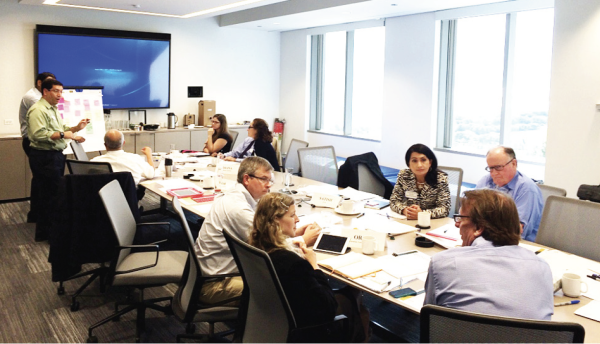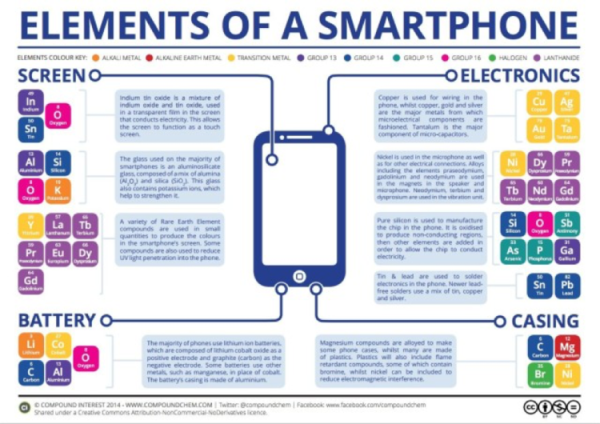Are you friends with the apps on your mobile device?
This may seem like a strange question, but ask yourself this as you read the following article.
I recently attended the 2015 Economist Innovation Forum in Chicago. The event attracted leading innovation thinkers and presentations covered topics ranging from trademark law to best practices for new product launches. Above all, navigating unpredictable market places and technological change appeared to be at the top of everyone’s minds.
These topics are also core areas of interest for Clareo. Robert Wolcott, Ph.D, Partner at Clareo and Professor of Innovation and Entrepreneurship at the Kellogg School of Management, touched on these issues during his presentation at the event:
“One of the critical trends impacting markets for the next generation is the emergence technologies that enable us to bring supply closer and closer to demand. Rideshare services like Uber place transportation at a customer’s fingertips and 3D printers bring physical prototyping to office spaces. The speed of commerce is accelerating and marketplaces are becoming less predictable.”
Building on this concept, I would argue that technology is shaping our viewpoints and giving rise to a full-blown “speed culture:” an environment where technology is shaping our perspectives in ways that cause us to expect expedient results.
The pitfall of expedient technologies is that they often provide fast and easy access at the expense of meaningful human interaction. In the following article, I will reflect on the event, explore how speed and technology compete with the “human” side of business, and explain why balancing the two is of notable importance to management and market strategy.
Looking Inward: Crowd Management
“It’s important to foster the innovation process by creating an environment that resembles something similar to the Japanese concept of Kaizen. Entrepreneurship needs to be intertwined with employee ownership across business units.”
“We need to move beyond process and control. We live in an MBA culture and there is nothing about the word innovation in the word administration.”
Many attendees were fixated on product development, but we should first ask ourselves how speed culture is reshaping corporate capacity for innovation. I am convinced that speed culture has seeped through the world of product innovation and into the world of management innovation. As an example, a variety of crowdsourcing services for corporate talent have arisen to cater to our new technocratic preferences. Organizations can now use companies like SpareHire and HourlyNerd to tap talent on-demand via digital marketplaces as opposed to relying on in-house staff or offline freelancers. The question is what is the impact of speed culture on innovation capacity?
Ironically, some of the most forward-thinking research into the effect of technology on management was conducted by a tech company. Researchers at IBM explored the effect of open and crowd work platforms on team engagement (1). Their work included:
- The creation of marketplace application for sourcing change management professionals and assigning these individuals to specific initiatives
- An assessment of an existing crowd work system
- Running a crowdfunding model within a lab where employees could individually allocate budget towards projects deemed beneficial
The findings of the study yielded a variety of thought provoking results. Although crowd-based models enhanced employees’ sense of independence and corporate democracy, they also had the potential to create insider-outsider relationships and degrade the value of work-based social ties. For example, some workers displayed a lack of commitment in a crowdwork setting because both managers and staff could “dump” one another at any time. In other instances, crowdfunded projects became the bases for employees’ assessments of similarities or differences between themselves and others. This heightened sense of awareness sometimes led to fissures between individuals or groups that would have otherwise remained submerged. In the words of a chemist reflecting on projects proposed by computer science analytics staff, “They don’t get what I do, I don’t get what they do.” (2)
The interconnections between productivity, quality and social ties have also been studied elsewhere. A study from researchers at Oxford and Harvard focused on over 1,000 projects and over 11,000 employees at a Bangalore-based software company named WinPro (3). “Familiarity” was defined and examined by counting the number of times team members had worked together over the previous three years and scaling the results based on the number of people on the team. Findings revealed that when familiarity increased by 50% product defects decreased by 19% and deviation from budget decreased by 30%. What is perhaps most impressive is that team familiarity was a better predictor of performance than individual project manager experience.
Organizations should pause and evaluate the relationship between speed culture and team building. Technological practices such as “crowd management” often provide flexibility and efficiency, but this needs to be balanced with appropriate team engagement. Without sustainable interaction, teams may run the risk of decreased output quality, project ownership, and overall innovation capacity.
Looking Outward: Social Relationships
“We would like to have a retail-like environment in healthcare. We want to be able to engage the consumer on a daily basis. We want to find ways to focus our offerings around the individual and their specific needs.”
“It’s really creepy. Sometimes I Google things and it’s tracking my previous searches so that it knows what I’m looking for. I feel strange knowing an unknown group of people at Google or an inanimate technology are tracking my behavior. It makes me think of the Wizard of Oz with the little man behind the curtain.”
Expedient technologies have complex implications for market strategy. Our technocratic society has chipped away at social interaction and created unmet needs surrounding human experience. Organizations often risk customer alienation or lack of differentiation due to lack of social engagement.
Experiential Retail
An interesting example of matching a social solution with a technological solution is Nordstrom’s recent acquisition of Trunk Club. According to Trunk Club’s website:
“Trunk Club was started to solve a simple problem – shopping for clothes in stores or online just doesn’t work for most guys. It’s overwhelming and inconvenient. With Trunk Club, guys discover awesome clothes that are perfect for them without ever having to go shopping. We combine top brands, expert service, and unparalleled convenience to deliver a highly personalized experience that helps guys look their best.”
As opposed to traditional online retailing, Trunk Club introduces social experience into the buying equation. Out of curiosity, I visited Trunk Club’s Chicago location for myself. Customers are offered complimentary drinks at an in-house bar, socialize with a personal stylist, and are encouraged to relax in a setting that feels more like a living room than a clothing store. Trunk Club also uses technology to support social experience through their mobile app, as can be seen with the following video:
Since 2009, the company has grown to 500 employees, including 250 stylists (4). With Trunk Club’s $350m price tag (5), it appears that Nordstrom bought into the idea that “shopping online just doesn’t work for most guys.”
Playing the Blame Game
I frequently attend pitch sessions and venture capital events in the Chicago area. It’s not uncommon at these events to encounter entrepreneurs that are looking to automate the functions currently filled by financial advisors.
Despite entrepreneurial onslaught and competition from discount brokers, many wealth management units have recovered and maintained profitability post-recession. Morgan Stanley and Merrill Lynch are running 20% and 25% pre-tax margins, respectively (6). Why are wealth management units showing resiliency in the face discount brokers, “robo advisors”, and in some cases, competition from index funds? The answer might lie in relationship-based nature of wealth management. According to the Economist:
“There may be another, psychological, reason why investors want to pay for advice: the avoidance of regret. If you choose to put all your money into technology stocks on the back of your own research, and such stocks collapse, you only have yourself to blame. But if you have listened to the advice of an expert, then the decision is not your fault.” (7)
It may not be the most pleasant type of social interaction, but investors may feel more comfortable with hand holding so that they have someone to blame. The stress and anxiety of self-reproach may be alleviated when one works with a financial advisor. The allure of working directly with a perceived expert may also bolster faith in wealth managers.
In light of the recurring demand for financial advisors, some discount brokers have switched their strategies. For example, Fidelity recently launched eMoney, a set of products designed to support financial advisors (8). This highlights the fact that technology can often be used as a tool to bolster experiential services, as opposed to simply replacing them. As for “robo advisor” entrepreneurs, they may find they face more of an uphill battle than previously thought.
Looking to the Future
“In our current environment, you need to be early to be on time. We need to ask ourselves how we can anticipate change.”
Ask yourself again: Are you friends with the apps on your mobile device?
I will use Uber as an example. If you use Uber, you have probably never been picked up by the same Uber driver twice and I imagine (and hope) that you feel more comfortable switching out ride-share services than your real-life human friends. Loyalty is compromised by the immediate and impersonal nature of the ride-sharing experience. The implications can be serious. For example, a number of my recent drivers have described intense price wars between Uber and Lyft. The challenge is that in an absence of meaningful customer experience these companies are differentiated on price as opposed to the actual service. Apparently, the drivers have similar feelings: they often tell me they drive for either service depending on their daily preference.
Moving forward, whether it is ride-share services, management, or new product development, I strongly believe that organizations should stop and consider the human side of innovation. Without a doubt, speed and access are clearly differentiators, but they need to be balanced with satisfying and sustainable experiences. Otherwise, organizations might find themselves lonely and unprofitable in the era of the crowd.
By Jonathan DeVito
________________________________________
[1]Cefkin, M., Anya, O., & Moore, R. (2014). A Perfect Storm, Reimagining Work in the Era of the End of the Job. Epic (Ethnographic Praxis in Industry Conference).
[2] Ibid.
[3] Huckman, R., & Staats, B. (December, 2013). The Hidden Benefits of Keeping Teams Intact. Harvard Business Review.
[4] Galland, Z. (2014, August 14). Nordstrom Reveals Price Tag for Trunk Club: $350 Million. Crain’s Chicago Business.
[5] Ibid.
[6] Survival of the Least Fit. (2015, February 15). The Economist.
[7] Not So Fit. (2012, June 9). The Economist.
[8] Ibid.


